Harvey Norman & JB Hi-Fi: E-Business Supply Chain Management Report
VerifiedAdded on 2023/06/05
|13
|1210
|371
Report
AI Summary
This report explores the integration of information technology and e-business and its transformative effect on supply chain management, evolving the process from mass production to mass customization. It assesses the impact of supply chain strategies on Harvey Norman and JB Hi-Fi, detailing their business models, customer and supplier relationships, and supply chain management approaches. Harvey Norman employs a complex model focusing on diversification and franchise organization, while JB Hi-Fi follows a franchise-based model emphasizing legal compliance. The report recommends JB Hi-Fi implement a logistics tracking system and Harvey Norman expand its website's user-friendliness. Ultimately, the report concludes that effective supply chain management is crucial for e-business success in the 21st century, highlighting the interdependence of business models and the advantages of proper tracking.

SUPPLY CHAIN
MANAGEMENT &
E-BUSINESS
MANAGEMENT &
E-BUSINESS
Paraphrase This Document
Need a fresh take? Get an instant paraphrase of this document with our AI Paraphraser
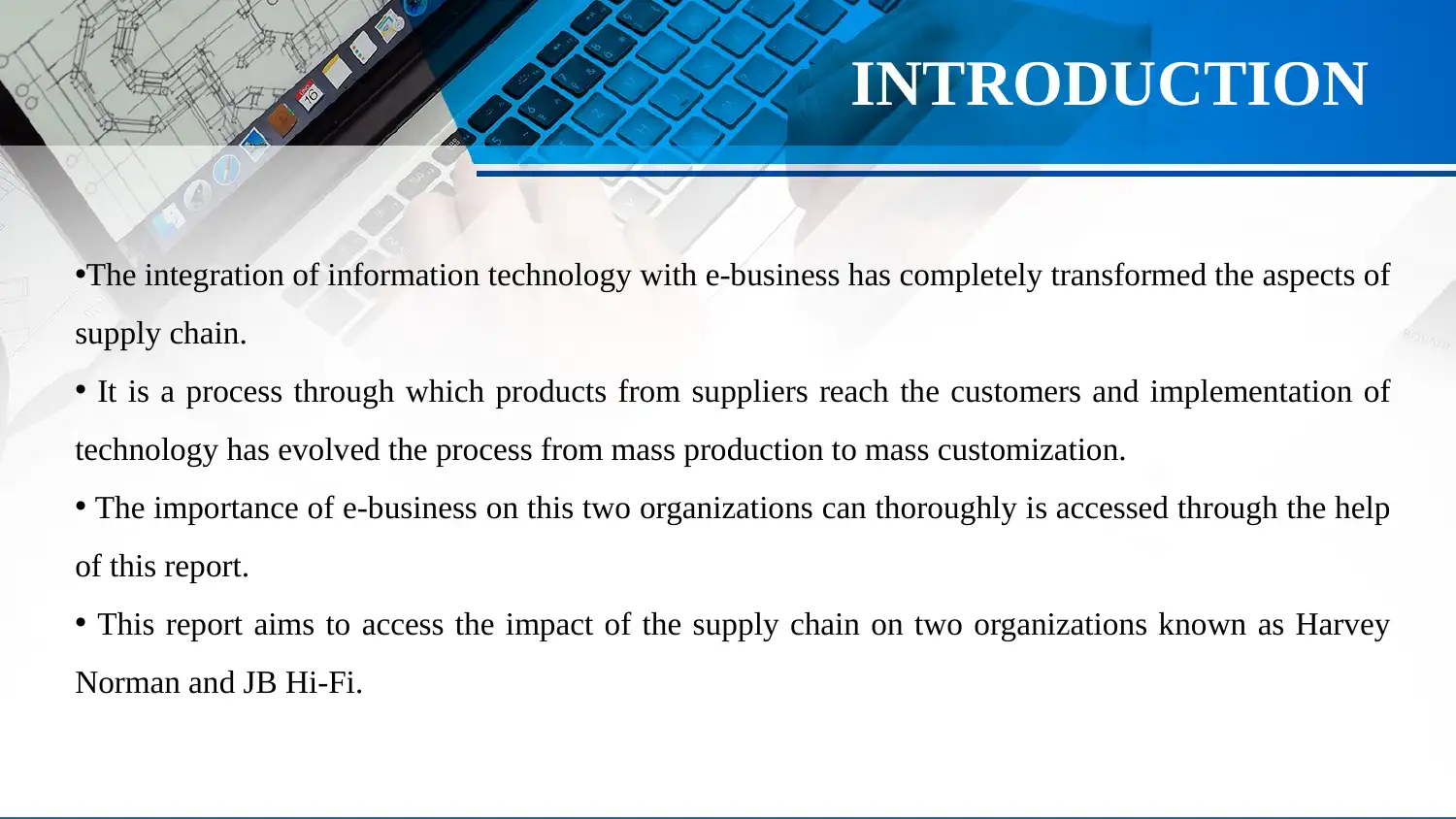
INTRODUCTION
•The integration of information technology with e-business has completely transformed the aspects of
supply chain.
• It is a process through which products from suppliers reach the customers and implementation of
technology has evolved the process from mass production to mass customization.
• The importance of e-business on this two organizations can thoroughly is accessed through the help
of this report.
• This report aims to access the impact of the supply chain on two organizations known as Harvey
Norman and JB Hi-Fi.
•The integration of information technology with e-business has completely transformed the aspects of
supply chain.
• It is a process through which products from suppliers reach the customers and implementation of
technology has evolved the process from mass production to mass customization.
• The importance of e-business on this two organizations can thoroughly is accessed through the help
of this report.
• This report aims to access the impact of the supply chain on two organizations known as Harvey
Norman and JB Hi-Fi.

COMPANY OF HARVEY NORMAN
• Retailer of furniture, computers and electrical products among others
• Consists of 57 franchise
• Has about 280 stores
• One of the core leaders in the technological market
(Source: harveynorman.com.au)
• Retailer of furniture, computers and electrical products among others
• Consists of 57 franchise
• Has about 280 stores
• One of the core leaders in the technological market
(Source: harveynorman.com.au)
⊘ This is a preview!⊘
Do you want full access?
Subscribe today to unlock all pages.

Trusted by 1+ million students worldwide

COMPANY OF JB HI-FI
• Retail company which mainly focuses on electronic goods and
communications
• Has 10 stores in Melbourne as well as Sydney
• Provides latest gadgets and technologies
(Source: jbhifi.com.au)
• Retail company which mainly focuses on electronic goods and
communications
• Has 10 stores in Melbourne as well as Sydney
• Provides latest gadgets and technologies
(Source: jbhifi.com.au)
Paraphrase This Document
Need a fresh take? Get an instant paraphrase of this document with our AI Paraphraser
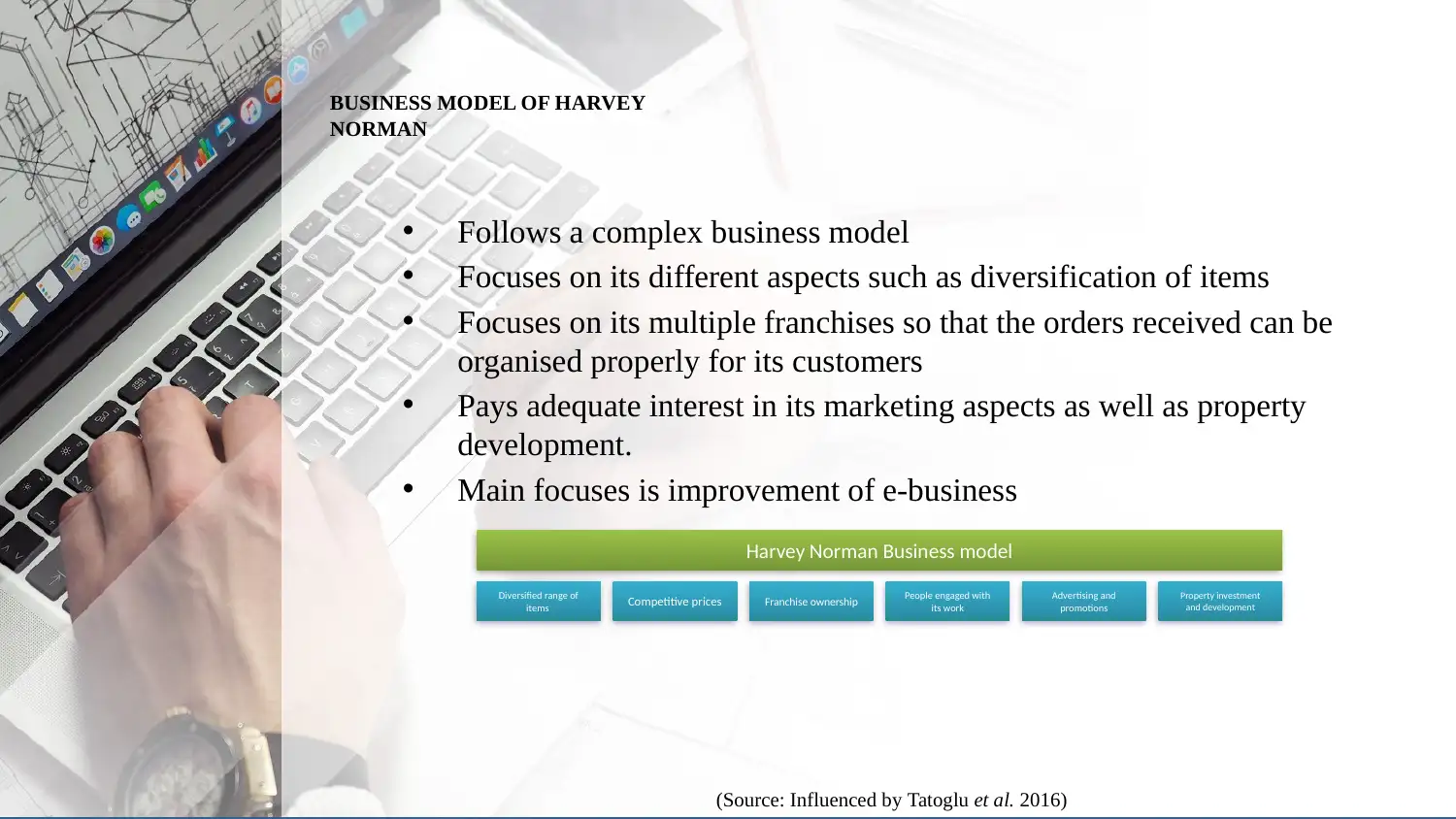
BUSINESS MODEL OF HARVEY
NORMAN
• Follows a complex business model
• Focuses on its different aspects such as diversification of items
• Focuses on its multiple franchises so that the orders received can be
organised properly for its customers
• Pays adequate interest in its marketing aspects as well as property
development.
• Main focuses is improvement of e-business
Harvey Norman Business model
Diversified range of
items Competitive prices Franchise ownership People engaged with
its work
Advertising and
promotions
Property investment
and development
(Source: Influenced by Tatoglu et al. 2016)
NORMAN
• Follows a complex business model
• Focuses on its different aspects such as diversification of items
• Focuses on its multiple franchises so that the orders received can be
organised properly for its customers
• Pays adequate interest in its marketing aspects as well as property
development.
• Main focuses is improvement of e-business
Harvey Norman Business model
Diversified range of
items Competitive prices Franchise ownership People engaged with
its work
Advertising and
promotions
Property investment
and development
(Source: Influenced by Tatoglu et al. 2016)
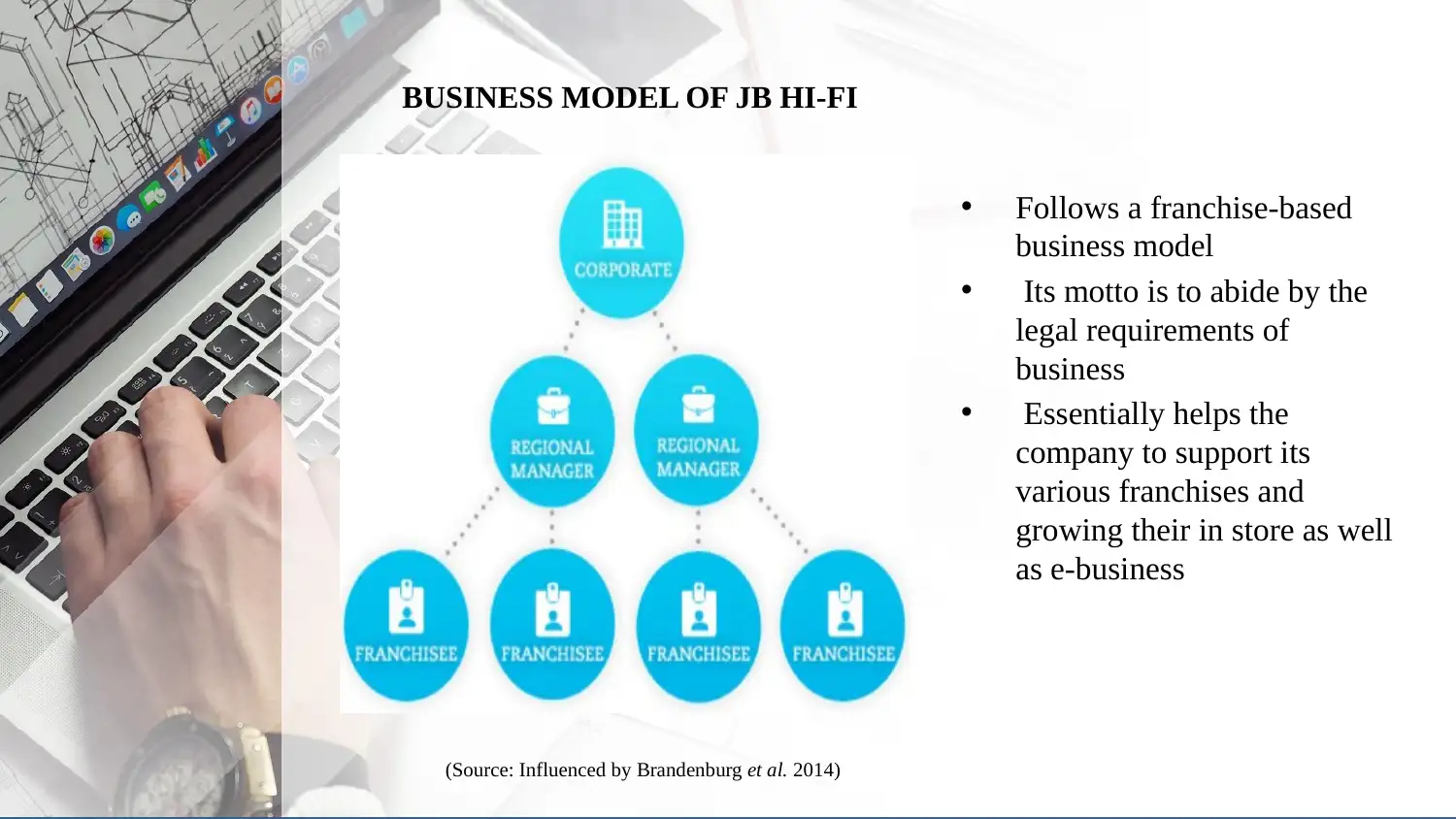
BUSINESS MODEL OF JB HI-FI
• Follows a franchise-based
business model
• Its motto is to abide by the
legal requirements of
business
• Essentially helps the
company to support its
various franchises and
growing their in store as well
as e-business
(Source: Influenced by Brandenburg et al. 2014)
• Follows a franchise-based
business model
• Its motto is to abide by the
legal requirements of
business
• Essentially helps the
company to support its
various franchises and
growing their in store as well
as e-business
(Source: Influenced by Brandenburg et al. 2014)
⊘ This is a preview!⊘
Do you want full access?
Subscribe today to unlock all pages.

Trusted by 1+ million students worldwide
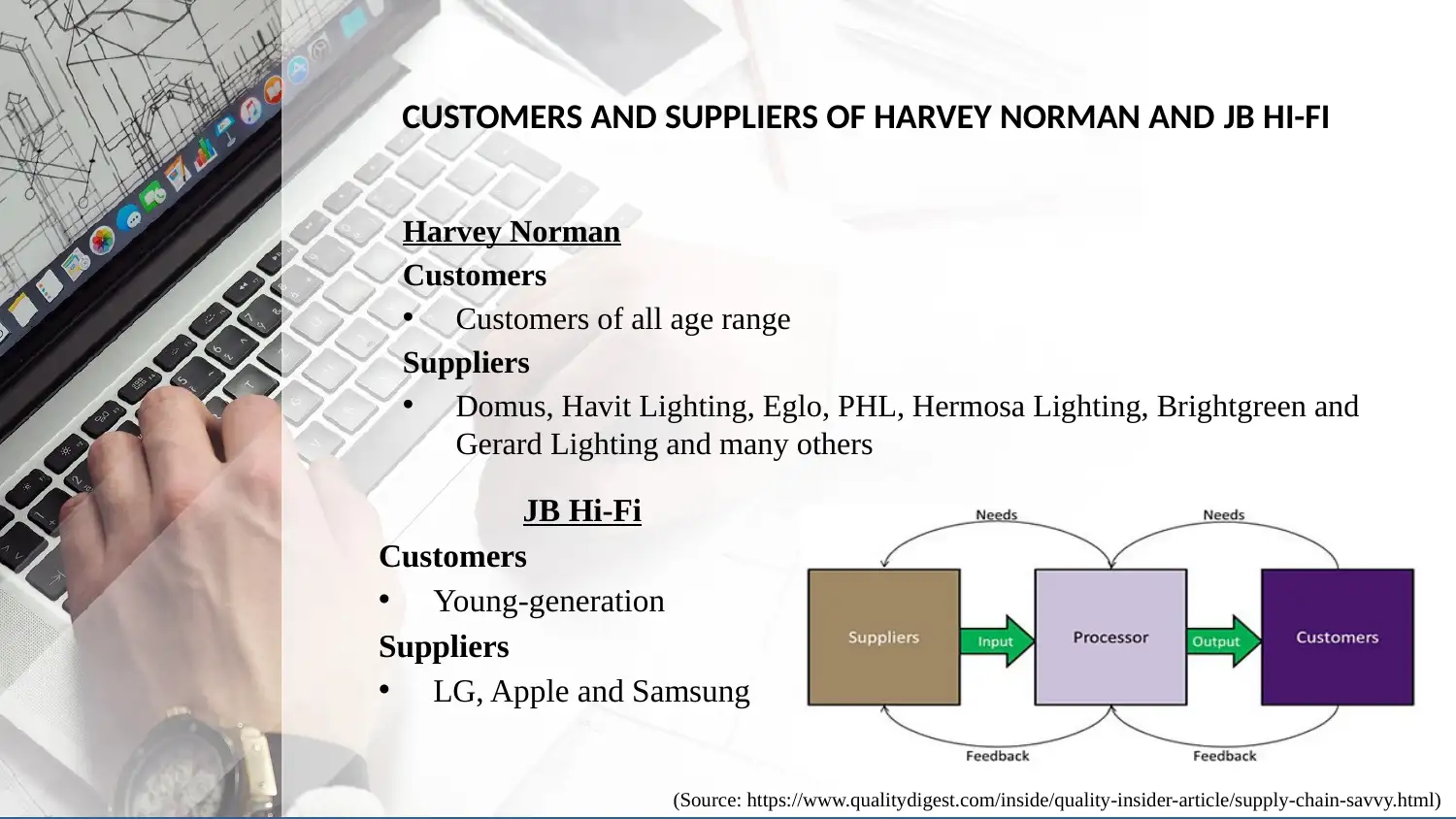
CUSTOMERS AND SUPPLIERS OF HARVEY NORMAN AND JB HI-FI
Harvey Norman
Customers
• Customers of all age range
Suppliers
• Domus, Havit Lighting, Eglo, PHL, Hermosa Lighting, Brightgreen and
Gerard Lighting and many others
JB Hi-Fi
Customers
• Young-generation
Suppliers
• LG, Apple and Samsung
(Source: https://www.qualitydigest.com/inside/quality-insider-article/supply-chain-savvy.html)
Harvey Norman
Customers
• Customers of all age range
Suppliers
• Domus, Havit Lighting, Eglo, PHL, Hermosa Lighting, Brightgreen and
Gerard Lighting and many others
JB Hi-Fi
Customers
• Young-generation
Suppliers
• LG, Apple and Samsung
(Source: https://www.qualitydigest.com/inside/quality-insider-article/supply-chain-savvy.html)
Paraphrase This Document
Need a fresh take? Get an instant paraphrase of this document with our AI Paraphraser
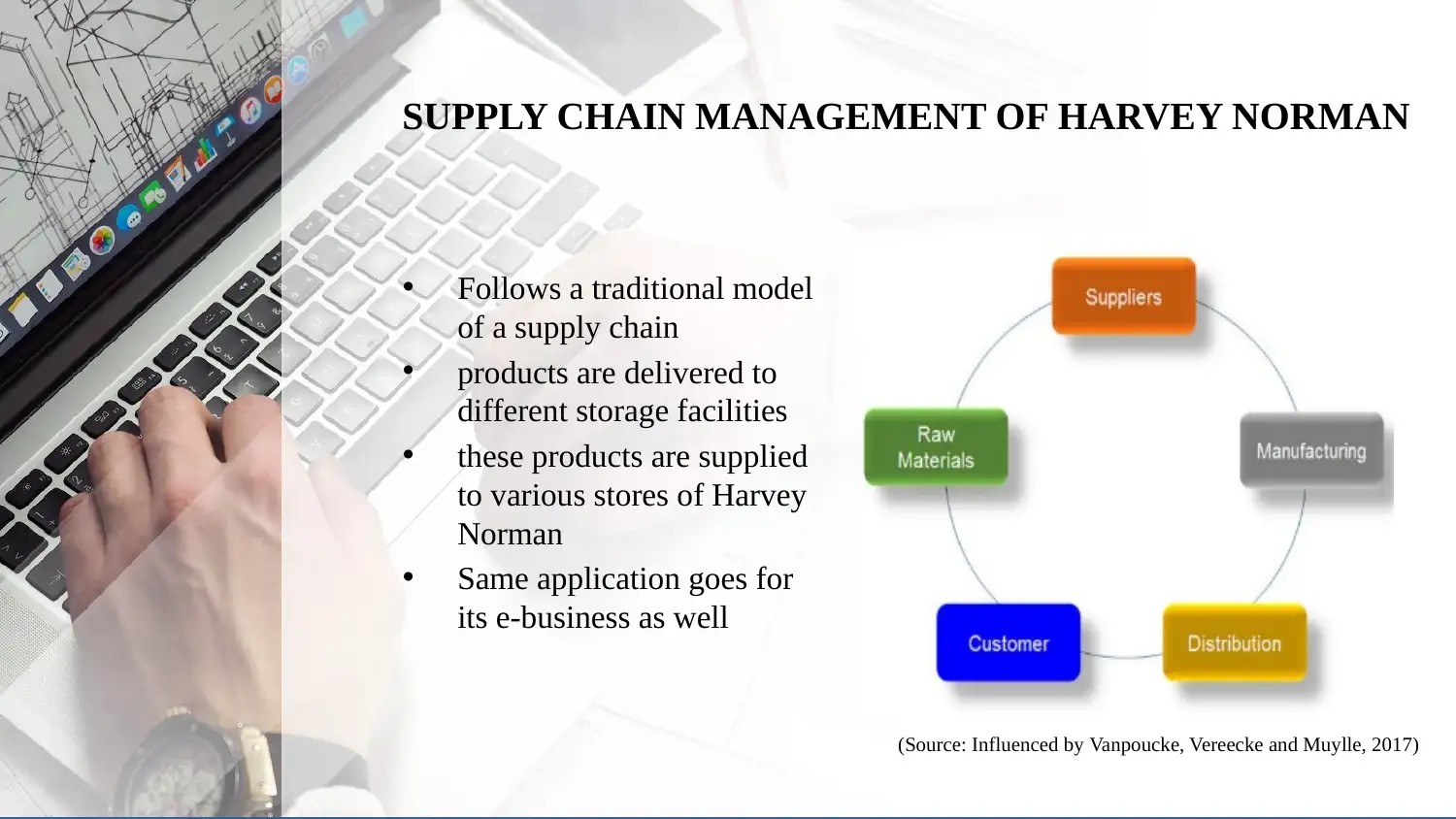
SUPPLY CHAIN MANAGEMENT OF HARVEY NORMAN
• Follows a traditional model
of a supply chain
• products are delivered to
different storage facilities
• these products are supplied
to various stores of Harvey
Norman
• Same application goes for
its e-business as well
(Source: Influenced by Vanpoucke, Vereecke and Muylle, 2017)
• Follows a traditional model
of a supply chain
• products are delivered to
different storage facilities
• these products are supplied
to various stores of Harvey
Norman
• Same application goes for
its e-business as well
(Source: Influenced by Vanpoucke, Vereecke and Muylle, 2017)
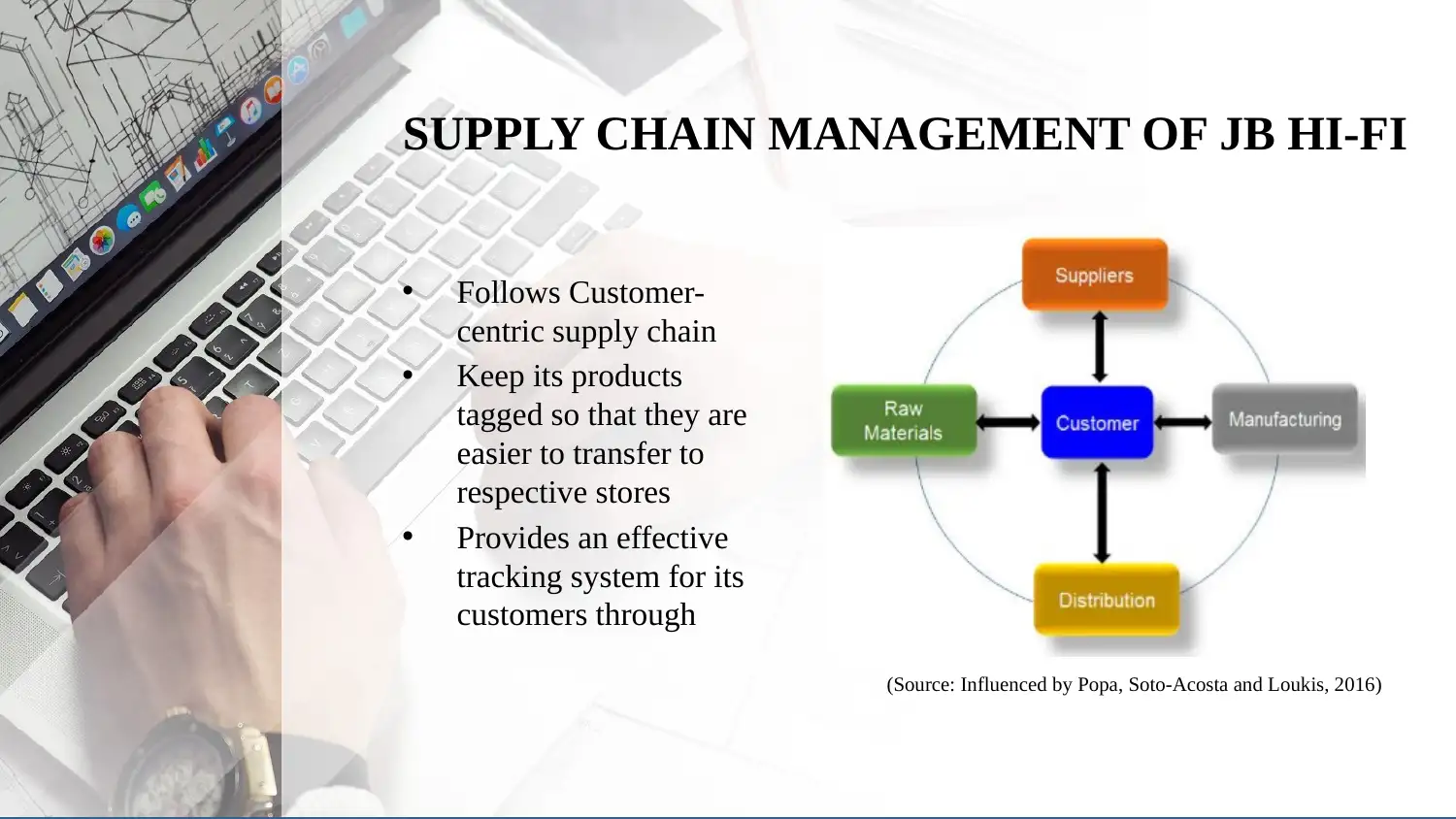
SUPPLY CHAIN MANAGEMENT OF JB HI-FI
• Follows Customer-
centric supply chain
• Keep its products
tagged so that they are
easier to transfer to
respective stores
• Provides an effective
tracking system for its
customers through
(Source: Influenced by Popa, Soto-Acosta and Loukis, 2016)
• Follows Customer-
centric supply chain
• Keep its products
tagged so that they are
easier to transfer to
respective stores
• Provides an effective
tracking system for its
customers through
(Source: Influenced by Popa, Soto-Acosta and Loukis, 2016)
⊘ This is a preview!⊘
Do you want full access?
Subscribe today to unlock all pages.

Trusted by 1+ million students worldwide
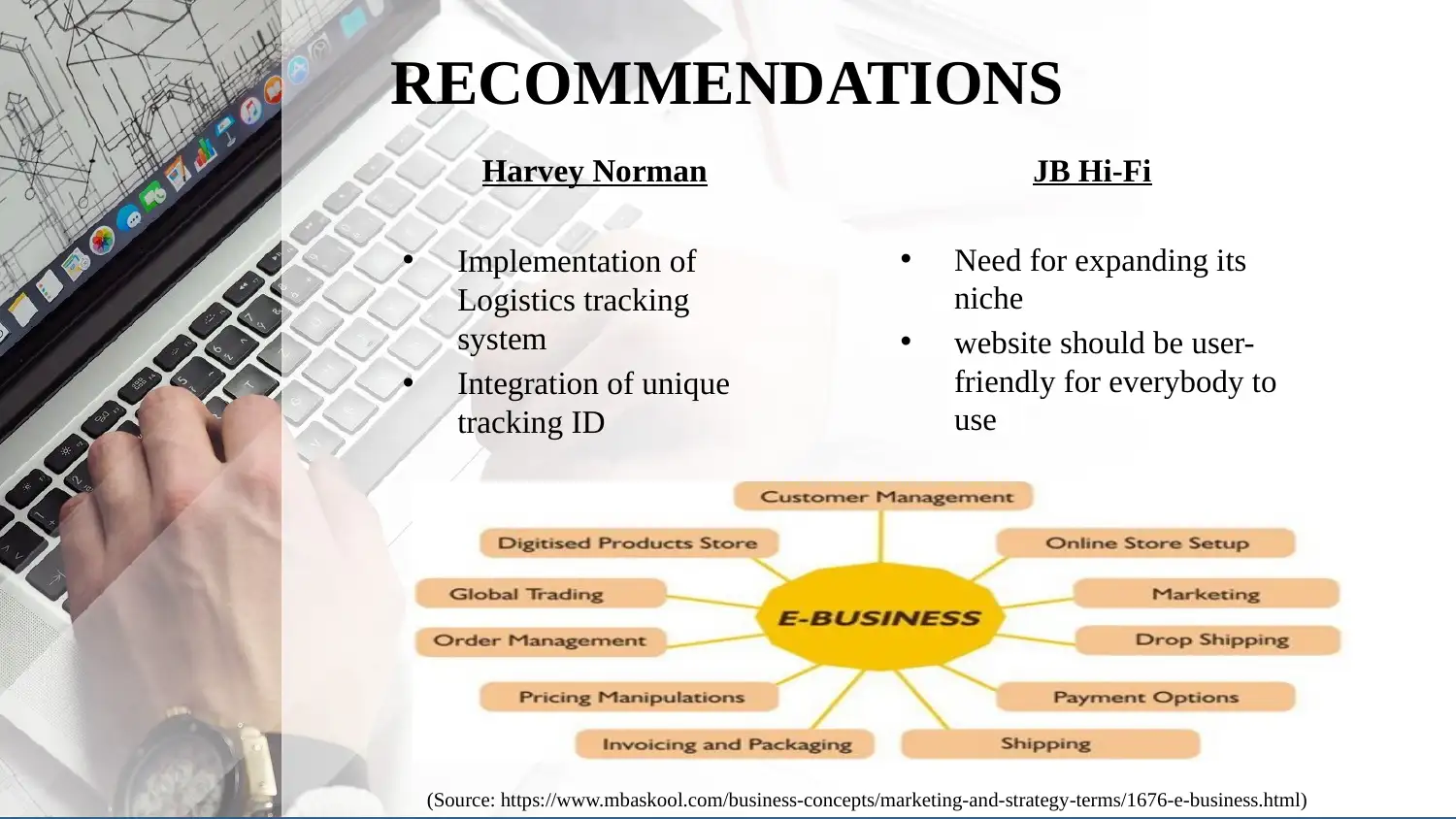
RECOMMENDATIONS
Harvey Norman
• Implementation of
Logistics tracking
system
• Integration of unique
tracking ID
JB Hi-Fi
• Need for expanding its
niche
• website should be user-
friendly for everybody to
use
(Source: https://www.mbaskool.com/business-concepts/marketing-and-strategy-terms/1676-e-business.html)
Harvey Norman
• Implementation of
Logistics tracking
system
• Integration of unique
tracking ID
JB Hi-Fi
• Need for expanding its
niche
• website should be user-
friendly for everybody to
use
(Source: https://www.mbaskool.com/business-concepts/marketing-and-strategy-terms/1676-e-business.html)
Paraphrase This Document
Need a fresh take? Get an instant paraphrase of this document with our AI Paraphraser
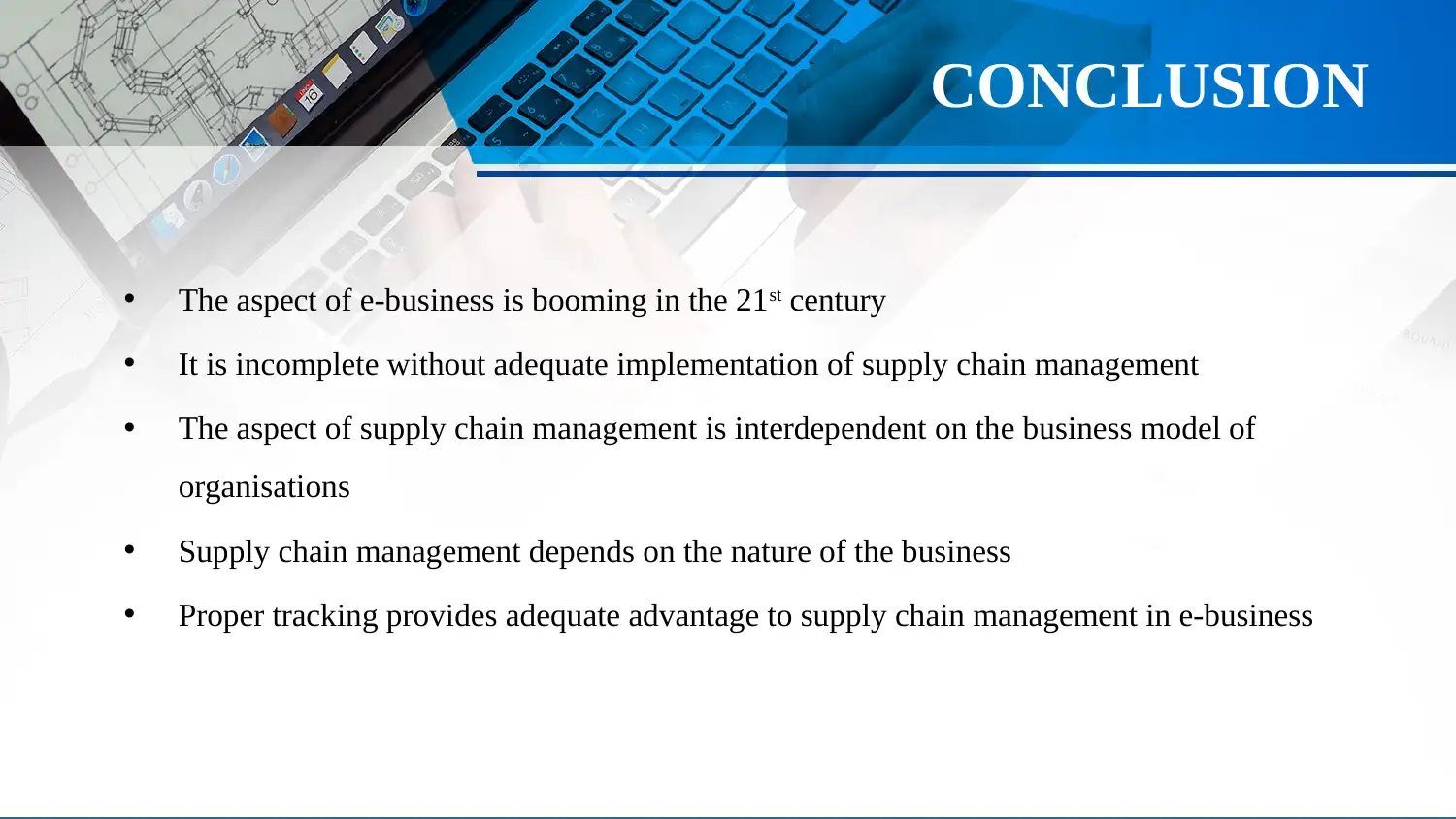
CONCLUSION
• The aspect of e-business is booming in the 21st century
• It is incomplete without adequate implementation of supply chain management
• The aspect of supply chain management is interdependent on the business model of
organisations
• Supply chain management depends on the nature of the business
• Proper tracking provides adequate advantage to supply chain management in e-business
• The aspect of e-business is booming in the 21st century
• It is incomplete without adequate implementation of supply chain management
• The aspect of supply chain management is interdependent on the business model of
organisations
• Supply chain management depends on the nature of the business
• Proper tracking provides adequate advantage to supply chain management in e-business
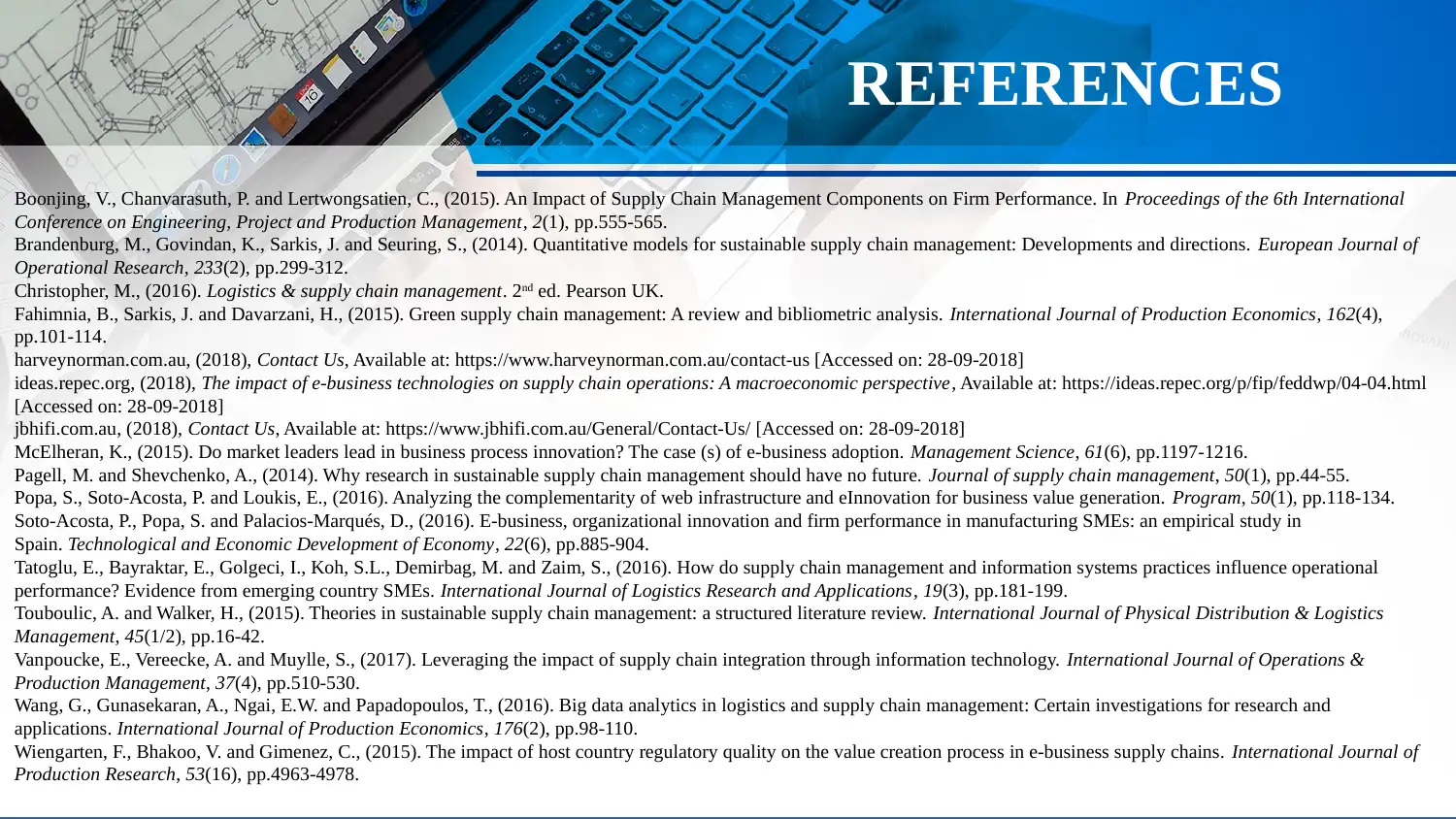
REFERENCES
Boonjing, V., Chanvarasuth, P. and Lertwongsatien, C., (2015). An Impact of Supply Chain Management Components on Firm Performance. In Proceedings of the 6th International
Conference on Engineering, Project and Production Management, 2(1), pp.555-565.
Brandenburg, M., Govindan, K., Sarkis, J. and Seuring, S., (2014). Quantitative models for sustainable supply chain management: Developments and directions. European Journal of
Operational Research, 233(2), pp.299-312.
Christopher, M., (2016). Logistics & supply chain management. 2nd ed. Pearson UK.
Fahimnia, B., Sarkis, J. and Davarzani, H., (2015). Green supply chain management: A review and bibliometric analysis. International Journal of Production Economics, 162(4),
pp.101-114.
harveynorman.com.au, (2018), Contact Us, Available at: https://www.harveynorman.com.au/contact-us [Accessed on: 28-09-2018]
ideas.repec.org, (2018), The impact of e-business technologies on supply chain operations: A macroeconomic perspective, Available at: https://ideas.repec.org/p/fip/feddwp/04-04.html
[Accessed on: 28-09-2018]
jbhifi.com.au, (2018), Contact Us, Available at: https://www.jbhifi.com.au/General/Contact-Us/ [Accessed on: 28-09-2018]
McElheran, K., (2015). Do market leaders lead in business process innovation? The case (s) of e-business adoption. Management Science, 61(6), pp.1197-1216.
Pagell, M. and Shevchenko, A., (2014). Why research in sustainable supply chain management should have no future. Journal of supply chain management, 50(1), pp.44-55.
Popa, S., Soto-Acosta, P. and Loukis, E., (2016). Analyzing the complementarity of web infrastructure and eInnovation for business value generation. Program, 50(1), pp.118-134.
Soto-Acosta, P., Popa, S. and Palacios-Marqués, D., (2016). E-business, organizational innovation and firm performance in manufacturing SMEs: an empirical study in
Spain. Technological and Economic Development of Economy, 22(6), pp.885-904.
Tatoglu, E., Bayraktar, E., Golgeci, I., Koh, S.L., Demirbag, M. and Zaim, S., (2016). How do supply chain management and information systems practices influence operational
performance? Evidence from emerging country SMEs. International Journal of Logistics Research and Applications, 19(3), pp.181-199.
Touboulic, A. and Walker, H., (2015). Theories in sustainable supply chain management: a structured literature review. International Journal of Physical Distribution & Logistics
Management, 45(1/2), pp.16-42.
Vanpoucke, E., Vereecke, A. and Muylle, S., (2017). Leveraging the impact of supply chain integration through information technology. International Journal of Operations &
Production Management, 37(4), pp.510-530.
Wang, G., Gunasekaran, A., Ngai, E.W. and Papadopoulos, T., (2016). Big data analytics in logistics and supply chain management: Certain investigations for research and
applications. International Journal of Production Economics, 176(2), pp.98-110.
Wiengarten, F., Bhakoo, V. and Gimenez, C., (2015). The impact of host country regulatory quality on the value creation process in e-business supply chains. International Journal of
Production Research, 53(16), pp.4963-4978.
Boonjing, V., Chanvarasuth, P. and Lertwongsatien, C., (2015). An Impact of Supply Chain Management Components on Firm Performance. In Proceedings of the 6th International
Conference on Engineering, Project and Production Management, 2(1), pp.555-565.
Brandenburg, M., Govindan, K., Sarkis, J. and Seuring, S., (2014). Quantitative models for sustainable supply chain management: Developments and directions. European Journal of
Operational Research, 233(2), pp.299-312.
Christopher, M., (2016). Logistics & supply chain management. 2nd ed. Pearson UK.
Fahimnia, B., Sarkis, J. and Davarzani, H., (2015). Green supply chain management: A review and bibliometric analysis. International Journal of Production Economics, 162(4),
pp.101-114.
harveynorman.com.au, (2018), Contact Us, Available at: https://www.harveynorman.com.au/contact-us [Accessed on: 28-09-2018]
ideas.repec.org, (2018), The impact of e-business technologies on supply chain operations: A macroeconomic perspective, Available at: https://ideas.repec.org/p/fip/feddwp/04-04.html
[Accessed on: 28-09-2018]
jbhifi.com.au, (2018), Contact Us, Available at: https://www.jbhifi.com.au/General/Contact-Us/ [Accessed on: 28-09-2018]
McElheran, K., (2015). Do market leaders lead in business process innovation? The case (s) of e-business adoption. Management Science, 61(6), pp.1197-1216.
Pagell, M. and Shevchenko, A., (2014). Why research in sustainable supply chain management should have no future. Journal of supply chain management, 50(1), pp.44-55.
Popa, S., Soto-Acosta, P. and Loukis, E., (2016). Analyzing the complementarity of web infrastructure and eInnovation for business value generation. Program, 50(1), pp.118-134.
Soto-Acosta, P., Popa, S. and Palacios-Marqués, D., (2016). E-business, organizational innovation and firm performance in manufacturing SMEs: an empirical study in
Spain. Technological and Economic Development of Economy, 22(6), pp.885-904.
Tatoglu, E., Bayraktar, E., Golgeci, I., Koh, S.L., Demirbag, M. and Zaim, S., (2016). How do supply chain management and information systems practices influence operational
performance? Evidence from emerging country SMEs. International Journal of Logistics Research and Applications, 19(3), pp.181-199.
Touboulic, A. and Walker, H., (2015). Theories in sustainable supply chain management: a structured literature review. International Journal of Physical Distribution & Logistics
Management, 45(1/2), pp.16-42.
Vanpoucke, E., Vereecke, A. and Muylle, S., (2017). Leveraging the impact of supply chain integration through information technology. International Journal of Operations &
Production Management, 37(4), pp.510-530.
Wang, G., Gunasekaran, A., Ngai, E.W. and Papadopoulos, T., (2016). Big data analytics in logistics and supply chain management: Certain investigations for research and
applications. International Journal of Production Economics, 176(2), pp.98-110.
Wiengarten, F., Bhakoo, V. and Gimenez, C., (2015). The impact of host country regulatory quality on the value creation process in e-business supply chains. International Journal of
Production Research, 53(16), pp.4963-4978.
⊘ This is a preview!⊘
Do you want full access?
Subscribe today to unlock all pages.

Trusted by 1+ million students worldwide
1 out of 13
Related Documents
Your All-in-One AI-Powered Toolkit for Academic Success.
+13062052269
info@desklib.com
Available 24*7 on WhatsApp / Email
![[object Object]](/_next/static/media/star-bottom.7253800d.svg)
Unlock your academic potential
Copyright © 2020–2025 A2Z Services. All Rights Reserved. Developed and managed by ZUCOL.





